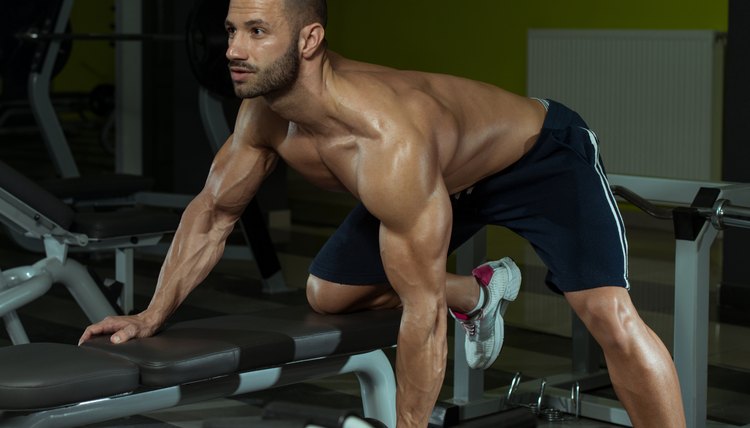Pullover Exercise Machines

According to Arthur Jones, founder and chief designer of Nautilus exercise equipment, the pullover exercise machine works so many muscles it can be considered as a squat for the upper body. This statement has since been echoed by strength expert and author Dr. Ellington Darden. Jones made good use of the pullover machine when, in 1973, he trained champion bodybuilder Casey Viator, who subsequently gained 63 lbs. in a single month. Jones attributed the results of these workouts, which were dubbed the Colorado Experiment, to the use of prototype Nautilus strength training equipment and, in particular, the pullover machine.
Muscles Recruited in the Pullover
The pullover is primarily performed as a latissimus dorsi exercise. Lats for short, these are the large fan-shaped muscles that extend from your armpits down toward your lower back and hips. In addition to your lats, pullovers strongly stimulate your triceps located on the rear of your upper arm and also your pectoralis major or pecs. The muscles between your shoulder blades -- the middle trapezius and rhomboids -- work very hard to keep your shoulder girdle stable during pullovers and your posterior deltoids or rear shoulder muscles provide a final push as you drive your elbows down and back.
Methodology
To get the most from using a pullover machine it is important that you perform the exercise correctly. Adjust the seat so that the machine's pivot point is aligned with the center of your shoulder. Secure yourself in position using the waist belt. Push down on the foot pedal so you can reach up and grasp the bar. Place your elbows on the arm pads and grip the handrail firmly. Release the foot pedal and take the weight on your arms. Lead with your elbows and drive your arms down and back as far as you can -- really squeeze your back muscles. Pause in this most contracted position and then slowly stretch up as far as comfortable. Pause in this stretched position for a second and then repeat. On completion of your set, use the foot pedal to help you lower the weight.
Advantages and Disadvantages
The pullover machine allows you to work your latissimus dorsi muscles in isolation from your arms. Most lat exercise rely as much on arm strength as the do upper back strength. Biceps strength is often the weak link when you perform lat exercises. By eliminating the involvement of your biceps, you are free to focus purely on lat development. The large range of movement used in the pullover machine exercise requires good shoulder flexibility and mobility. If you have stiff or otherwise weak shoulders, this exercise may prove injurious.
Alternatives
Not every gym is equipped with a pullover machine, but you can perform a similarly effective exercise using a flat exercise bench and free weights. Lie across a bench with your feet flat on the floor, your upper back resting on the bench and your lower back tightly arched. Hold a barbell with a shoulder width overhand grip directly over your chest. Bend your arms slightly and then keep them rigid throughout the exercise. Lower the weight down behind your head so that your biceps are close to your ears. Raise your arms back up to the starting position and then repeat. You can also perform this exercise using a single dumbbell held in both hands or a dumbbell in each hand.
References
- Nautilus Training Principles; Arthur Jones
- The New High Intensity Training: The Best Muscle-Building System You've Never Tried"; Ellington Darden Ph.D.
- Anatomy of Exercise: A Trainer's Inside Guide to Your Workout" Pat Manocchia
- Janyacharoen T, Thayon M, Bushong W, Jaikla N, Sawanyawisuth K. Effects of resistance exercise on cardiopulmonary factors in sedentary individuals. J Phys Ther Sci. 2016;28(1):213–217. doi:10.1589/jpts.28.213
- Hedayatpour N, Falla D. Physiological and neural adaptations to eccentric exercise: Mechanisms and considerations for training. Biomed Res Int. 2015;2015:193741. doi:10.1155/2015/193741
- de Almeida Costa Campos Y, Fernandes da Silva S. Comparison of electromyographic activity during the bench press and barbell pullover exercises. Motriz: Revista de Educação Física. 2014;20(2):200–205. doi:10.1590/s1980-65742014000200010
- Marchetti PH, Uchida MC. Effects of the pullover exercise on the pectoralis major and latissimus dorsi muscles as evaluated by EMG. J Appl Biomech. 2011;27(4):380-4. doi:10.1123/jab.27.4.380
- Battaglia C, di Cagno A, Fiorilli G et al. Benefits of selected physical exercise programs in detention: a randomized controlled study. Int J Environ Res Public Health. 2013;10(11):5683–5696. doi:10.3390/ijerph10115683
- Jeno SH, Varacallo M. Anatomy, Back, Latissimus Dorsi. In: StatPearls [Internet]. Treasure Island (FL): StatPearls Publishing. Updated April 5, 2019.
- Solari F, Burns B. Anatomy, Thorax, Pectoralis Major. In: StatPearls. Treasure Island (FL): StatPearls Publishing. Updated December 9, 2018.
- Stastny P, Gołaś A, Blazek D, et al. A systematic review of surface electromyography analyses of the bench press movement task. PLoS One. 2017;12(2):e0171632. doi:10.1371/journal.pone.0171632
Resources
Writer Bio
Patrick Dale is an experienced writer who has written for a plethora of international publications. A lecturer and trainer of trainers, he is a contributor to "Ultra-FIT" magazine and has been involved in fitness for more than 22 years. He authored the books "Military Fitness", "Live Long, Live Strong" and "No Gym? No Problem!" and served in the Royal Marines for five years.
